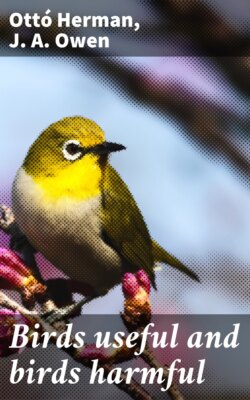Читать книгу Birds useful and birds harmful - J. A. Owen - Страница 7
На сайте Литреса книга снята с продажи.
The Barn Owl: White or Church Owl.
(Strix Flammea.)
ОглавлениеTable of Contents
The Barn Owl builds no regular nest, but lays its eggs in the walls of ruined castles, on the inner sills of towers, or in the dust and sweepings that collect in the corners of granaries. The clutch consists of five, occasionally seven, longish white eggs.
This bird likes always to be close to the abode of man; she likes to make her nest among the rafters of some warm barn and in other farm buildings, or in church tower or belfry; in hollow trees, a cleft in wall or cliff; semi-obscure corners, those even in broad daylight. There she sits, putting herself now and again in grotesque positions, and when that facial disk is stirred she appears to be, as the children say, “pulling faces” at you. One of the most industrious of hunters, she catches far more mice than she can devour. It is true she takes the bat, who has his own insect-destroying work to do; and when she has the chance she will cause havoc in the nest of a small bird. But this is only an occasional outbreak, and it must not weigh against the general good record of this most useful species. She takes living prey, and will only touch carrion under extreme stress of hunger.
The Barn or White Owl is generally distributed throughout Great Britain. It suffered at one time most undeservedly from the ignorant prejudices of many gamekeepers, and of late years from the senseless fashion of women wearing the wings and head in their headgear—a crowning folly only perpetrated through that ignorant vanity which knows neither love nor pity.
Colonel Irby said that this Owl, which is most useful to man, can be preserved and increased by fixing an 18-gallon cask in a tree. The barrel should be placed on its side and have a hole cut in the upper part of the head for the Owls to enter; care must, however, be taken that Jackdaws do not take possession of the cask.
Our gamekeepers are beginning now to be convinced of the usefulness of the Owl, especially in view of the fact that so many young birds are taken by the Brown Rat, a favourite quarry with the Owl—not to speak of the Voles and Mice the bird devours. The late Lord Lilford told me that he had watched a nest of young Owls being fed by their parents in an old cedar tree in the rectory garden of a relative, and that on one occasion the old birds came bringing food to these seventeen times in half an hour by the clock, on that evening. There was a rickyard not far from the nest which was the Owls’ favourite hunting-ground. Mice were not plentiful there, but rats swarmed, and the pellets found under the nest were here composed almost entirely of the remains of the latter. In the South of France and in Spain this Owl is accused of drinking oil from lamps in the peasants’ houses and in the churches and chapels. The name given to it in the former country by the peasant of the Midi is Béou l’oli—bird that drinks oil. Attracted by the light of the lamps, the poor Owl perhaps has entered, once in a way, and in its fright has upset a lamp. Superstition grows on very meagre fare. This ally of the agriculturalist has been ill-repaid for his services.
Butler writes:—
